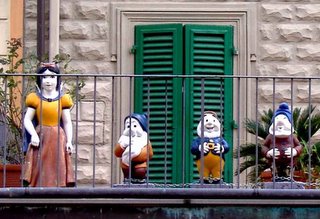
Hide Your Euros
The Ponte Vecchio is the oldest bridge in Florence. The others were blown to bits in World War II to prevent the Allies from getting across the Arno and getting in line ahead of the Germans for tickets to the Ufizzi. Unlike most bridges in the world, this bridge is not about connecting two points, this bridge is a destination unto itself…or so several hundred thousand tourists are led to believe daily. “Ponte Vecchio” literally means old bridge, named so because in the time it takes to travel through the throngs from one end to the other you may discover that you have become a grandparent. I was skeptical about this thing from the moment I saw it filled with people. I have a general rule of thumb that has served me well, never hang around a place where lots of people mill around listlessly like stadium rock concerts and jail. I mean, this is a bridge and an old bridge at that (old as in 1345, not old as in 1945), and if you think it is a good idea to tread over something that old and creaky along with tons (and I mean, literally, tons) of other folks, that’s your business. High on my business agenda is staying alive to have at least one more capucinno and pasta dolce.
If you want to make sure that you will not be missing anything by staying on the shore, the following fact-finding report is provided here as a public service so that you do not have to go yourself. This is what you will see if you walk across the Ponte Vecchio:
1. Lots of jewelry, most of it real gold, in the store windows that line the bridge.
2. Lots of jewelry most of it not real gold inserted into fleshy mounds of teenage flesh.
3. Guys taking pictures of their girlfriends.
4. Girls taking pictures of guys they wish were their boyfriends.
5. Guys taking pictures of famous Europeans that happen to be printed on the Euros in what used to be your wallet.
6. Jewelry store owners rubbing their hands together and panting slightly.
Review that list. Did I say anything about the spectacular view from the bridge? No? Hmm…could that be because is no spectacular view from this bridge?! A bridge with no view! Wow! Gotta see that, Marge! Actually there is a small opening at the peak between the shops that line the bridge but it is generally filled to the max with pickpockets smoking, trading quips, and counting out their nice, fresh Euros. The view itself is obscured by a statue that itself is obscured by the kajillion bicycle locks…hmm… maybe it’s not a sculpture? I don’t know what they hell it is. All I know is that people are taking pictures of the fence around it ‘cause it is covered with bicycle locks. And just where did those bicycle locks come from, anyway? From all the bicycles that were stolen to procure the locks. It is a folk art monument to petty crime and you can have your picture taken in front of it with somebody else’s boyfriend while somebody else’s girlfriend picks your pocket and the guy in the jewelry store window rubs his hands together.
The Medicis had a private hallway built above the bridge connecting various bits of Medici real estate. Back in the day, the Medici family ran this town and if they had to get from one side of the Arno to the other they sure as hell were not going to walk among the riff-raff and they already had all the gold jewelry anyone could want as well as all the boyfriends and girlfriends. And really, when you are that rich and powerful you do not care about having your picture taken next to a fence covered with bicycle locks (although there is a portrait in the Uffizi painted by Leonardo of Lorenzo de Medici the Moronic smiling like a dope next to the fence with a pair of bolt cutters in his hands). This elevated hallway, the so-called Vasari Corridor, is lined with paintings of self-portraits by such artists as Rembrandt, Rubens and Hogarth. As far as I know, to this day you must be somehow related to a Medici to gain access. There is also a rumor of a secret Medici tunnel running underneath the Ponte Vecchio lined with paintings on velvet of sad clowns. Adolph Hitler, an amateur painter, was known to have revered the sad-clown-on-velvet genre and this is the true reason why the bridge was not bombed by the Nazis.
